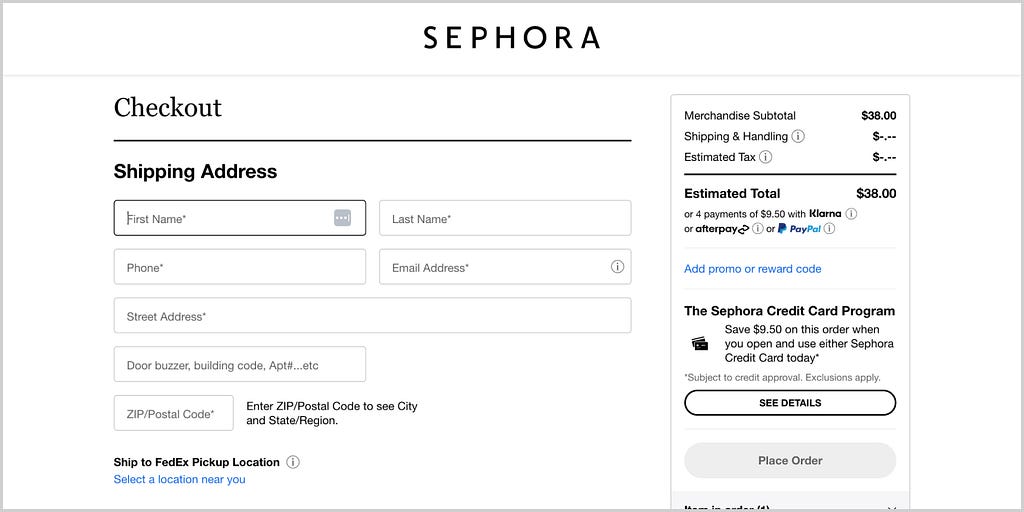Checkout is a common scenario that users encounter on countless websites daily. To achieve a high checkout completion rate on your e-commerce website, it’s essential to create a process that feels seamless and intuitive for your customers.
By adhering to industry standards and implementing proven best practices, you can enhance the user experience and drive significant business success. In this article, I’ll outline the most effective best practices for optimizing your checkout process.

Minimize Distractions and Visual Noise
Eliminating distractions is essential to keeping users focused on the checkout process. Remove any unnecessary elements that might divert attention or encourage customers to navigate away from the page. This includes removing the navigation menu, using a simple header and footer, and avoiding excessive graphic elements. By creating a clean, streamlined environment, you help customers stay engaged with the checkout process, reducing the likelihood of cart abandonment.

Organize and Optimize Checkout Flow
To create a smoother checkout experience, it’s essential to organize the information customers need to provide into logical sections. This approach makes the process feel more manageable and helps focus the customer’s attention on one task at a time. Here are four key sections to consider:
- Shipping Address. Ensure the shipping address form is user-friendly. Enhance usability by auto-filling fields such as postal code, city, and country based on the user’s IP address. Consider integrating Google Address suggestions to automatically populate the address fields.
- Delivery Method. Present all available shipping options along with their costs and estimated delivery dates. This clarity helps users make an informed decision.
- Payment Method. Offer relevant payment options tailored to the customer’s device and location. This increases the likelihood of completing this step smoothly.
- Review. Allow customers to review their orders before final submission. This step is a best practice that allows users to confirm their purchase details.
Some steps may be omitted if they do not apply to the purchase. For example, digital products don’t require a shipping address or delivery method. Likewise, if only one delivery option is available, there’s no need to prompt customers to choose.

Regarding checkout design, there are two main patterns:
- Multi-Step Checkout Flow is effective when each step involves significant input or decision-making. It breaks down the process into manageable stages, making it less overwhelming for the user.
- Single-page checkout works well for simpler checkouts. It consolidates all information into one page, providing a streamlined and immediate checkout experience.
Choosing between these patterns depends on the complexity of your checkout process and the nature of the purchased products.
Explicitly Display Order Tally
Pricing transparency is key to building buyer confidence and enhancing the overall customer experience. Clearly displaying the order tally, including item prices, shipping costs, taxes, and the total amount, ensures that customers are fully informed about what they’re paying. This level of detail not only meets industry standards but also addresses common customer concerns, helping to eliminate any confusion or hesitation during the checkout process.

Make Customer Feel Safe and Protected
Security is paramount during checkout, where customers share sensitive information such as payment details and home addresses. To build trust, incorporate recognizable security signals like SSL certificates, secure payment logos, and clear messaging that reinforces the safety of the transaction. Additionally, providing visible contact information or offering a live chat option reassures customers that assistance is readily available, further enhancing their sense of security throughout the checkout process.

Support Guest Checkout
While account creation is valuable for fostering customer loyalty and gathering insights, forcing it can result in abandoned carts. Offering a guest checkout option lets customers complete their purchases without the added friction of mandatory registration. You can still provide an option to create an account after the purchase is completed or even during the checkout process, making it easy and optional rather than a barrier to conversion.

Save Customer Data
Saving customers’ shipping information and payment details can significantly streamline the checkout experience for returning users. By optimizing the process for this group, you not only enhance their convenience but also improve your checkout completion rate and increase their lifetime value (LTV). Ensuring that customers can quickly and easily complete future purchases encourages repeat business and fosters long-term loyalty.

Effectively Handle Errors
Customers often encounter errors during the checkout process, such as field validation issues, payment processing failures, or back-end errors. Effectively managing these errors is crucial to keeping customers on track and preventing them from abandoning their purchases. By providing clear, actionable feedback and easy-to-follow solutions, you can help customers resolve issues quickly, ultimately improving your checkout completion rate.
For more insights on effectively handling errors during the checkout process, check out this article.

Implementing these best practices will enhance your checkout experience, leading to higher completion rates and greater business success.
Checkout UX Best Practices was originally published in UX Planet on Medium, where people are continuing the conversation by highlighting and responding to this story.